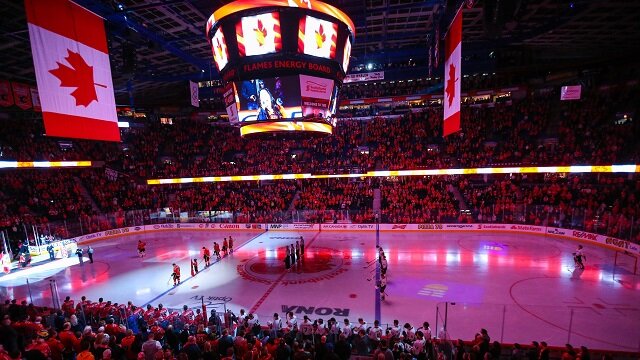Not even the NHL‘s Calgary Flames could avoid the devastating floods that have overwhelmed southern Alberta, Canada.
The team’s home arena — Scotiabank Saddledome — is reportedly filled with floodwater from the Bow River all the way up to the 10th row of seats. The jumbotron room and its equipment were destroyed, and the locker rooms sustained heavy damage as well. Calgary Sun columnist Eric Francis wrote on Friday night that “plenty of history will likely be ruined too, including a massive championship team photo from 1989 signed by most team members that hangs outside the Flames dressing room.”
The uniquely shaped Saddledome opened in 1983 as part of the city’s bid to host the 1988 Winter Olympic Games and to welcome the Flames, who moved from Atlanta in 1980. The arena, which has a seating capacity of 19,289 people, is one of the oldest arenas in the NHL, and the Flames’ organization reportedly is close to announcing plans for a new arena when the Saddledome’s lease expires in 2014. The arena is owned by the city and operated by the team. Francis tweeted that the flooding “will now play a role in the discussion.”
So far, three fatalities have been confirmed and 75,000 residents have been forced from their homes as Calgary’s entire downtown area was evacuated.
Canadian Prime Minister Stephen Harper, a Calgary resident, on Friday called the amount of flooding “stunning.”
There are many questions going forward. How much will it cost and how long will it take to get the Saddledome back in game shape? Will the Flames have to relocate? If so, where will they go? Flames president Ken King tweeted on the team’s Twitter account they will be ready for the start of the season, but there could be any number of unforeseen challenges that could cause delays.
The bigger picture is how the NHL and other sports leagues adapt their arenas and stadiums to a changing climate where there will be more extreme weather — floods, droughts, wildfires, hurricanes, rising sea levels. Should the NHL consider installing flood barriers at all arenas located near rivers, lakes and seas?
The list of NHL arena near bodies of water is a long one: Toronto’s Air Canada Centre is located near Lake Ontario; Montreal’s Bell Centre isn’t far from Lachine Canal; Nashville’s Bridgestone Arena is a stone’s throw from the Cumberland River; Pittsburgh’s Consol Energy Center is at the three rivers — Monongahela, Allegheny and Ohio; Buffalo’s First Niagara Center is along Lake Erie; Anaheim’s Honda Center is on the banks of the Santa Ana River; San Jose’s HP Pavilion is near the Guadalupe River; Jobing.com Arena in Glendale is near the New River; Detroit’s Joe Louis Arena overlooks the Detroit River; Winnipeg’s MTS Centre isn’t far from the Red River; Columbus’ Nationwide Arena is a few blocks from the Scioto River; Denver’s Pepsi Center is located near the South Platte River; Newark’s Prudential Center is near the Pasaic River; Edmonton’s Rexall Place is near the North Saskatchewan River; Vancouver’s Rogers Arena is between English Bay and Vancouver Harbor; St. Louis’ Scottrade Center is near the Mississippi River; Tampa Bay Times Forum is near Hillsborough Bay; Boston’s TD Garden is not far from the Charles River; Philadelphia’s Wells Fargo Center is close to the Delaware River; and The Xcel Energy Center in St. Paul is along the Mississippi River.
With so many NHL arenas threatened by bodies of water that could potentially overflow as the Arctic ice melts, the league should sit down with arena owners and come up with a climate adaptation plan. The NHL is already “going green” by partnering with the Natural Resource Defense Council and other environmental groups for the NHL Green website, where they promote measures such as reducing the environmental impact of the Stanley Cup playoffs. Getting their arenas climate ready is the next logical step.








